The Tapestry of Vietnamese Cuisine: Everything You Should Know
Vietnamese cuisine is a symphony of flavors, a culinary tapestry that weaves together history, culture, and a diverse array of ingredients. This article delves into the rich history of Vietnamese cuisine, exploring its origins, key ingredients, traditional dishes, regional variations, and the modern innovations that continue to shape its identity.
Contents
- 1. An Overview of Vietnamese Cuisine
- 2. The Origins of Vietnamese Food
- 3. Key Ingredients in Vietnamese Cooking
- 4. Regional Variations in Vietnamese Cuisine
- Vietnamese Street Food Culture
- Modern Innovations in Vietnamese Cuisine
- Health Benefits of Vietnamese Cuisine
- Conclusion: A Rich Tapestry of Flavors
- FAQs (Frequently Asked Questions)
1. An Overview of Vietnamese Cuisine
Vietnamese cuisine is celebrated worldwide for its balance of flavors, vibrant colors, and emphasis on fresh, aromatic ingredients. Rooted in a deep cultural history, Vietnamese food reflects the country’s agricultural abundance and the influence of various civilizations over the centuries.
2. The Origins of Vietnamese Food
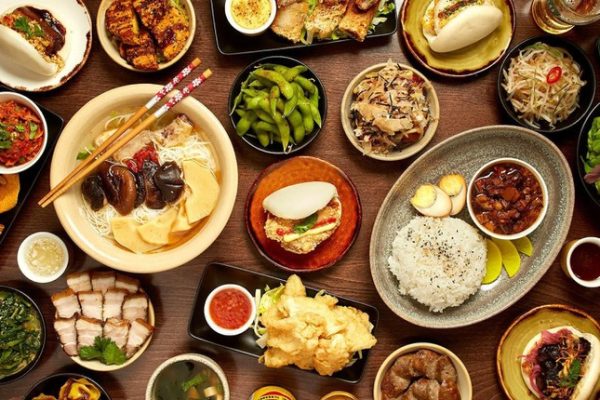
Early Influences
Vietnamese cuisine, with its rich tapestry of flavors, finds its origins deeply embedded in the ancient Viet people’s connection to the lush landscapes of the Red River Delta. This culinary journey begins with the cultivation of rice, a staple that not only sustained communities but also became a symbol of cultural significance.
Viet People and Rice Cultivation
The ancient Viet people’s mastery of rice cultivation in the Red River Delta laid the groundwork for what would later become the backbone of Vietnamese cuisine. The cultivation of rice not only provided sustenance but also shaped the culinary preferences and practices of the region.
Chinese Influences: Stir-Frying and Soy Sauce
Early interactions with China played a pivotal role in shaping Vietnamese culinary techniques. Influences from Chinese cuisine introduced the art of stir-frying, revolutionizing the way ingredients were prepared. Additionally, the use of soy sauce, a staple in Chinese cooking, became an integral part of the Vietnamese flavor palette, adding depth and savory notes to various dishes.
Spices from Indian and Thai Traders
The vibrant spices that characterize Vietnamese cuisine owe their introduction to the traders navigating Southeast Asian routes. Indian and Thai traders brought an exotic array of spices, enriching Vietnamese dishes with layers of complexity and fragrance. This infusion of flavors marked a transformative phase in the evolution of Vietnamese culinary artistry.
Cultural Influences
As Vietnam’s history unfolded, its cuisine underwent a dynamic evolution, shaped by cultural influences from neighboring countries and colonial powers.
Evolution Over Time
Vietnam’s culinary landscape reflects a journey of adaptation and evolution over time. The interplay between indigenous flavors and foreign elements created a distinctive culinary identity that showcases the country’s ability to absorb and innovate.
Colonial Impact on Culinary Identity
Colonial powers, notably the French, left an indelible mark on Vietnamese cuisine. The introduction of French culinary techniques and ingredients added a layer of sophistication, resulting in a fusion that birthed unique and flavorful creations. This melding of cultures enhanced rather than diluted the essence of Vietnamese gastronomy.
A Distinctive Culinary Identity
The interweaving of early influences from rice cultivation, Chinese culinary techniques, and the introduction of spices by Indian and Thai traders, coupled with ongoing cultural adaptations, has given rise to a distinctive Vietnamese culinary identity. It is a testament to the resilience of traditions while embracing the dynamism of external influences.
3. Key Ingredients in Vietnamese Cooking
Fish Sauce: The Heart of Vietnamese Flavor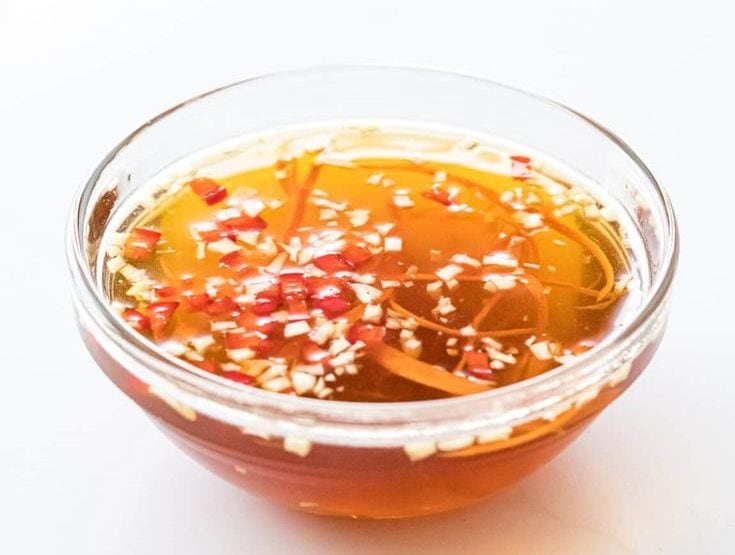
Central to Vietnamese cuisine is fish sauce, a condiment that plays a pivotal role in elevating the taste of various dishes. Crafted from fermented fish, this pungent and umami-rich sauce adds depth and complexity to Vietnamese cooking. Its roots delve deep into the country’s coastal geography, where fish have been a staple for generations. Whether used as a dipping sauce, a marinade, or a flavor enhancer in soups and stews, fish sauce is a fundamental component that embodies the soul of Vietnamese flavor.
Fresh Herbs and Vegetables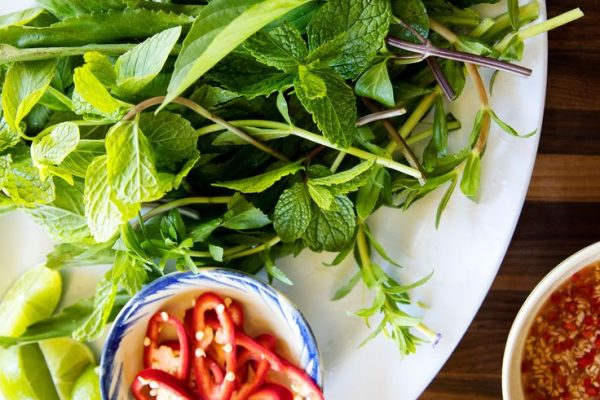
Vietnamese cuisine embraces a vibrant array of fresh herbs and vegetables, adding not only color but also a burst of freshness and nutritional value to every meal. Staples like mint, cilantro, and basil are commonly used, imparting a fragrant and aromatic quality to dishes. Vegetables, from crisp bean sprouts to crunchy cucumbers, are not mere accompaniments but integral components that contribute to the overall balance and healthfulness of Vietnamese cuisine.
Rice: A Staple in Vietnamese Meals
Rice, often referred to as the staff of life, holds a special and symbolic place in Vietnamese culture. It is more than just a side dish; it is a fundamental element present in every meal, reflecting the nation’s deep agrarian heritage. The majority of Vietnamese households consume rice daily, whether in the form of steamed white rice, rice noodles, or rice paper used in various dishes. Its versatility and central role signify not just sustenance but a connection to tradition and a way of life.
4. Regional Variations in Vietnamese Cuisine
Vietnamese cuisine is a mosaic of flavors and culinary traditions, with distinct regional variations that reflect the diverse landscapes and cultural influences throughout the country.
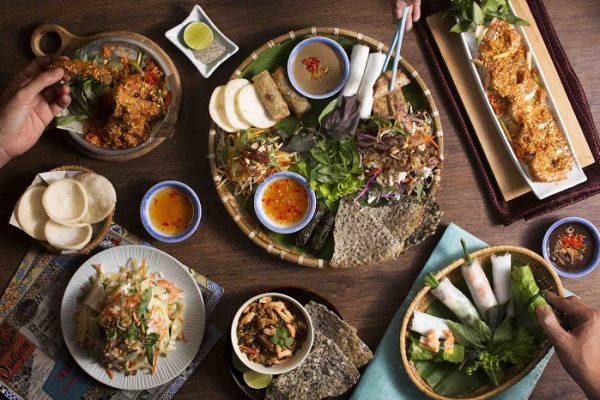
Northern Cuisine
Northern Vietnamese cuisine is characterized by its milder flavors and a reliance on freshwater ingredients. The cool climate of the north influences the use of ingredients such as freshwater fish, prawns, and herbs. The culinary traditions in the north also bear the imprint of Chinese influence, evident in the cooking techniques and flavor profiles. Noodle dishes, especially those incorporating rice noodles, are prevalent in the north, reflecting the influence of Chinese noodle culture.
Central Cuisine
Central Vietnam offers a bold and spicy culinary experience, setting it apart from the other regions. The region’s imperial history has significantly influenced its diverse range of dishes. The imperial city of Hue, for instance, has left an indelible mark on the cuisine, with a focus on intricate preparation and vibrant presentation. Central Vietnamese dishes often feature bold flavors, incorporating chili peppers for a spicy kick. The cuisine of this region is a celebration of the rich history and cultural heritage that defines Central Vietnam.
Southern Cuisine
Southern Vietnamese cuisine is renowned for its sweetness and the use of tropical fruits. The Mekong Delta’s fertile lands contribute to an abundance of fresh produce, and the region’s proximity to the sea influences its seafood-centric dishes. The use of coconut milk, herbs, and a harmonious balance of sweet and savory flavors distinguishes Southern cuisine. Popular dishes like “Cơm Niêu” (broken rice) and “Bánh Mì” (Vietnamese sandwich) find their roots in the south, showcasing the region’s culinary creativity.
Vietnamese Street Food Culture
Vietnam’s vibrant street food culture is a delightful reflection of the nation’s passion for on-the-go dining. The bustling streets, adorned with the enticing aromas of sizzling delicacies, beckon locals and tourists alike on a culinary adventure waiting to be explored.
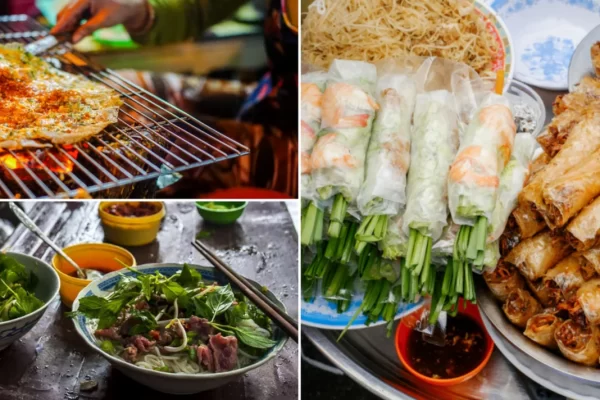
A Symphony of Aromas
Walking through the streets of Vietnam, one is immediately captivated by the symphony of aromas emanating from street food stalls. The air is filled with the enticing scents of grilled meats, fragrant herbs, and simmering broths, creating an immersive experience for all who wander through these vibrant food havens.
On-the-Go Delicacies
Vietnamese street food offers a diverse array of on-the-go delicacies, each a testament to the nation’s culinary creativity. Steaming bowls of pho, Vietnam’s iconic noodle soup, draw crowds with their rich and aromatic broths. Banh mi, the beloved Vietnamese sandwich, is a perfect fusion of French and local flavors, featuring a crisp baguette filled with a medley of ingredients such as meats, pickled vegetables, and fresh herbs.
Savory Snacks and Quick Bites
The streets of Vietnam are adorned with an abundance of savory snacks and quick bites. From crispy spring rolls (nem ran) to flavorful rice paper rolls (goi cuon), every corner seems to reveal a new gastronomic delight. Vendors skillfully craft these snacks, ensuring a perfect balance of textures and flavors that captivate the taste buds.
Iconic Street Food Hubs
Certain cities and regions in Vietnam have gained renown for their unique street food offerings. Hanoi, with its labyrinthine alleys and Old Quarter, is a haven for those seeking the authentic flavors of pho and bun cha. Ho Chi Minh City, on the other hand, boasts a dynamic street food scene, offering everything from hu tieu (noodle soup) to com tam (broken rice) dishes.
Discover the top 10 must-try authentic Vietnamese dishes in Hanoi.
Modern Innovations in Vietnamese Cuisine
Vietnamese cuisine, deeply rooted in tradition, has not been immune to the winds of change. In recent years, a wave of innovation has swept through kitchens across Vietnam, with modern chefs at the forefront, redefining the boundaries of traditional flavors.
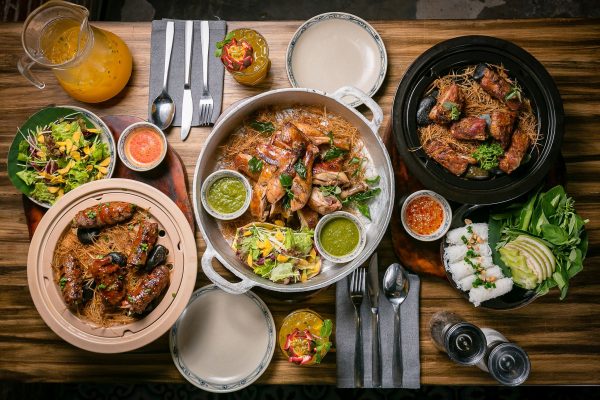
Embracing Evolution
While the foundations of Vietnamese cuisine remain steadfast, modern chefs are unafraid to embrace evolution. Experimentation with new techniques and a willingness to incorporate global influences have given rise to a new era of Vietnamese gastronomy.
Fusion of Flavors
One notable trend in modern Vietnamese cuisine is the fusion of flavors. Chefs are creatively blending traditional Vietnamese ingredients with elements from diverse culinary traditions worldwide. This fusion not only adds excitement to familiar dishes but also introduces a global dimension that resonates with contemporary palates.
Playful Presentations
Presentation has become an art form in modern Vietnamese dining. Chefs are not only focused on flavor but also on creating visually stunning dishes. The aesthetics of a plate are now as important as the taste, offering a multisensory experience to diners.
Innovative Techniques
Innovative cooking techniques have found their way into Vietnamese kitchens. From molecular gastronomy to sous-vide cooking, chefs are exploring new methods to enhance textures, intensify flavors, and create novel dining experiences. These techniques, once considered avant-garde, are becoming integral to the evolution of Vietnamese culinary arts.
Sustainable Practices
A growing awareness of environmental issues has prompted a shift toward sustainable practices in Vietnamese kitchens. Chefs are increasingly sourcing local, seasonal ingredients and adopting eco-friendly cooking methods. This commitment to sustainability not only aligns with global trends but also reflects a deeper connection to the country’s agricultural roots.
Culinary Cross-Pollination
The exchange of culinary ideas on a global scale has influenced Vietnamese chefs to explore beyond traditional boundaries. International collaborations and exposure to diverse cuisines have led to a cross-pollination of culinary concepts, resulting in innovative dishes that showcase a harmonious blend of flavors.
Nostalgic Innovations
In addition to forward-looking innovations, modern Vietnamese cuisine also pays homage to nostalgia. Chefs are rediscovering and reinventing classic recipes, infusing them with a contemporary twist. This trend bridges the gap between generations, appealing to both traditionalists and those seeking a taste of the past with a modern flair.
Health Benefits of Vietnamese Cuisine
Vietnamese cuisine has long been celebrated not only for its exquisite flavors but also for its inherent focus on fresh, natural ingredients, making it a culinary choice that aligns well with a healthy and balanced lifestyle.
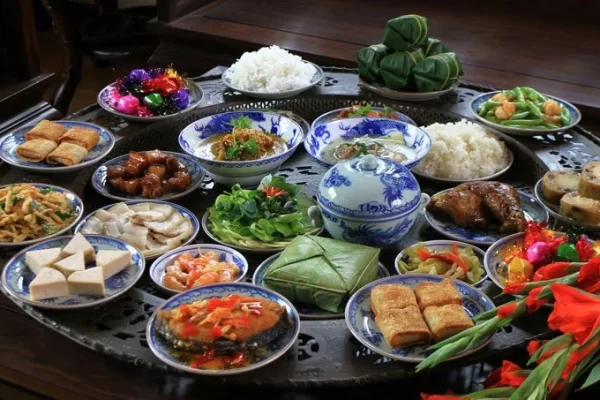
Nutrient-Rich Herbs
A distinctive feature of Vietnamese cuisine is the abundant use of fresh herbs. From aromatic mint and cilantro to basil and lemongrass, these herbs not only add vibrant flavors but also bring a plethora of health benefits. Rich in vitamins, minerals, and antioxidants, these herbs contribute to overall well-being and support the body’s immune system.
Lean Proteins
Proteins are a fundamental building block of a healthy diet, and Vietnamese cuisine incorporates lean protein sources judiciously. Whether it’s grilled fish, steamed chicken, or tofu, Vietnamese dishes prioritize proteins that are not only delicious but also lower in saturated fats. This emphasis on lean proteins promotes muscle health and provides sustained energy.
Abundance of Vegetables
Vegetables take center stage in Vietnamese cooking, providing a spectrum of essential nutrients. From crisp bean sprouts and water spinach to bok choy and broccoli, Vietnamese dishes feature a colorful array of vegetables. This not only enhances the visual appeal of meals but also ensures a diverse range of vitamins, minerals, and dietary fiber essential for digestive health.
Balanced Flavors with Minimal Oil
Vietnamese cuisine achieves a harmonious balance of flavors without relying heavily on oil and excessive fats. The emphasis on fresh ingredients and herbs, and the use of broth in many dishes allow for robust flavors without compromising on health. This approach makes Vietnamese meals not only delicious but also heart-healthy, supporting cardiovascular well-being.
Minimal Processed Ingredients
Another health-conscious aspect of Vietnamese cuisine is the limited use of processed ingredients. The focus on whole, unprocessed foods ensures that diners enjoy meals with minimal additives, preservatives, and artificial flavorings. This commitment to simplicity and purity contributes to the overall nutritional value of Vietnamese dishes.
Inclusion of Rice
Rice, a staple in Vietnamese meals, serves as a healthy source of carbohydrates. It provides sustained energy, and when consumed in moderation, it contributes to a well-rounded diet. The emphasis on rice reflects a cultural approach to nutrition, acknowledging the importance of this grain in providing essential nutrients.
Hydration through Soups and Broths
Many Vietnamese dishes, such as pho and bun, feature clear and nourishing broths. These not only enhance flavors but also contribute to hydration. The inclusion of broth-based dishes in the cuisine adds to the overall fluid intake, promoting good hydration and supporting various bodily functions.
Conclusion: A Rich Tapestry of Flavors
In conclusion, Vietnamese cuisine is a journey through history, culture, and a diverse landscape of flavors. From the bustling streets of Hanoi to the Mekong Delta’s tranquil waters, each dish tells a story of Vietnam’s resilience and culinary artistry.
At Red Bean Restaurant, we invite you not only to savor the delightful flavors but to embark on a gastronomic adventure that narrates the tales of Vietnam’s history, culture, and culinary craftsmanship. Come, let your taste buds wander through the diverse landscapes of Vietnam right here on your plate.
FAQs (Frequently Asked Questions)
What is the significance of fish sauce in Vietnamese cooking?
- Fish sauce is a fundamental ingredient in Vietnamese cooking, providing a savory and umami-rich flavor to many dishes. It is often considered the heart of Vietnamese flavor.
How does French colonization impact modern Vietnamese cuisine?
- French colonization introduced culinary techniques and ingredients that melded with Vietnamese traditions, giving rise to unique dishes. Elements like baking and sauces continue to influence modern Vietnamese cuisine.
Are there vegetarian options in Vietnamese cuisine?
- Yes, Vietnamese cuisine offers a variety of vegetarian dishes, often featuring tofu, vegetables, and aromatic herbs. Some popular choices include vegetarian pho and spring rolls.
What makes Vietnamese street food unique?
- Vietnamese street food is known for its diversity and accessibility. From savory noodle soups to grilled delicacies, street vendors offer an authentic and affordable culinary experience.
Can I find regional variations of Vietnamese cuisine outside of Vietnam?
- Yes, many Vietnamese restaurants worldwide strive to represent regional variations, offering a taste of Northern, Central, and Southern Vietnamese flavors.
How important is rice in Vietnamese cuisine?
- Rice is a staple in Vietnamese meals, symbolizing the country’s agrarian heritage. It is not only a side dish but a fundamental component of many iconic Vietnamese dishes.
What are some traditional Vietnamese beverages?
- Traditional Vietnamese beverages include iced coffee (cà phê sữa đá), herbal teas, and refreshing fruit drinks. These beverages complement the diverse flavors of Vietnamese cuisine.
Is Vietnamese cuisine considered healthy?
- Yes, Vietnamese cuisine is often regarded as healthy due to its emphasis on fresh ingredients, herbs, and lean proteins. The balance of flavors and minimal use of oil contribute to its healthful reputation.
How can I experience Vietnamese culinary tourism?
- To experience Vietnamese culinary tourism, consider joining guided food tours, participating in cooking classes, and exploring local markets. These immersive experiences offer insights into the country’s rich culinary heritage.
EHG – Elegance Hospitality Group.
Image source: Collected.